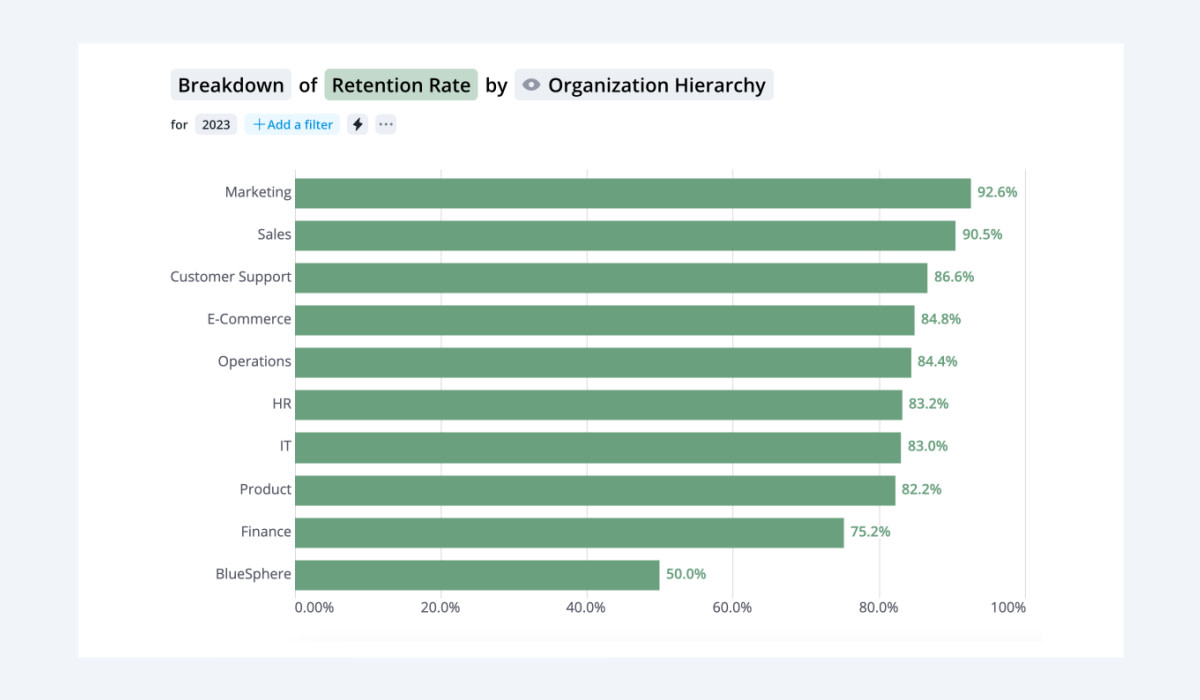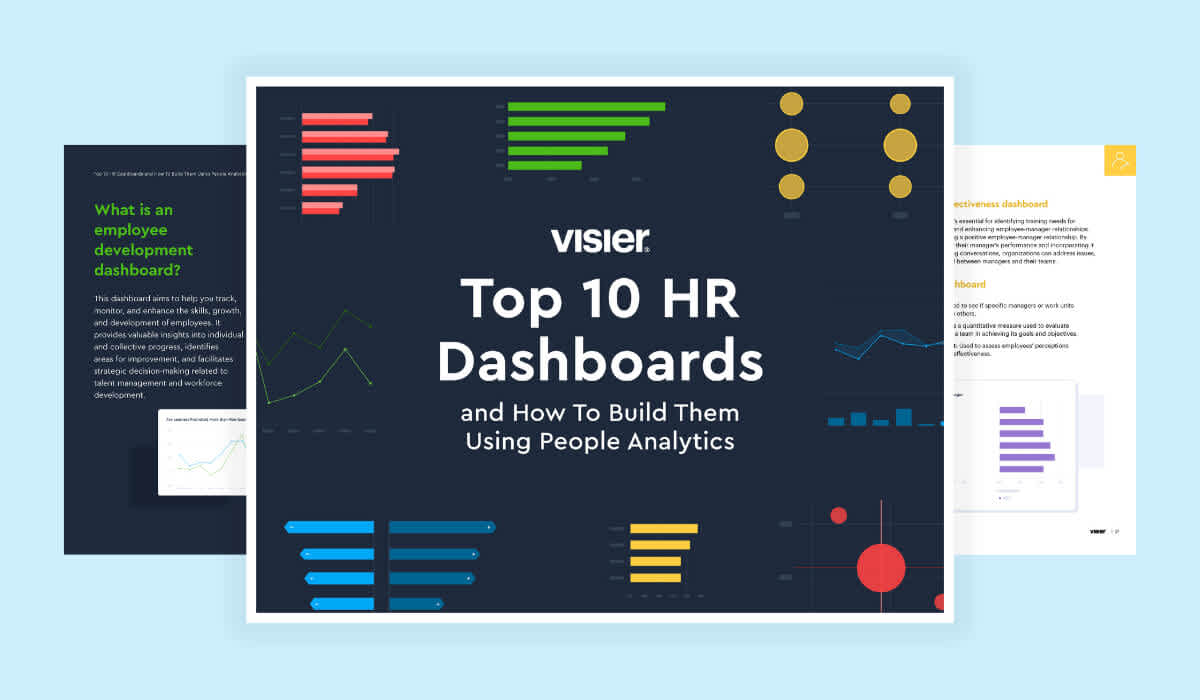How To Calculate Employee Retention Rate (With Formulas)
Understanding the employee retention rate (and why it's changing) will help you stay on top of positive and negative trends that impact performance.

Your employees play a critical role in the success of your company. The employee retention rate is a must-track HR metric that helps you understand your workforce and how many people choose to stay with your organization. Here’s a guide on how to calculate employee retention rates at your organization.

What is employee retention rate?
Employee retention rate is the percentage of employees that stay with your company during a set period of time.
You’ll often hear about turnover rates—how many employees left your company during a certain period. The retention rate is the opposite. Instead of focusing on those who leave, you’re focusing on those who stay.
The importance of retention rate
The employee retention rate is arguably one of your most important HR metrics. Here’s how it can help you.
Improved retention strategies. Understanding your retention rate can help you create better retention strategies, ensuring top performers stay with the company longer.
Saved costs. Hiring can be a costly process. By tracking your retention rate, you can find ways to reduce voluntary attrition and save costs that would otherwise be wasted on replacing people who leave.
Improved productivity. Focusing on retention brings stability to your teams. Stable teams are more productive and engaged, leading to better results for the company.
Succession planning. If you want to create a successful succession plan, you need to understand your retention rates. This helps you understand who is likely to stay, and who is at risk of leaving.
Strategic workforce planning. Tracking your retention rates helps you understand and address several areas of your business, including skill gaps, engagement, and more.
Why you need to track employee retention rate
Few things are worse for a business than seeing employee after employee leave your company and having no idea why that is. Understanding your retention rates can help you focus your effort on the correct strategies that will boost retention, productivity, and engagement.
Good employee retention means more productivity. Teams where people continuously come and go will inevitably have a drop in performance. At the opposite end, those with high retention rates can see improved productivity and performance. They work well with each other, understand their strengths and weaknesses, and can use them to improve their workflow.
Plus, replacing even a single employee can come with huge costs. You’ll need to spend time finding the right person and training them. The time to productivity is not always short. And when we’re talking about highly specialized skills, the effort to replace a person will be even greater.
Low retention rates can signal bigger problems within the company. For instance, employees often leave if they feel they don’t have enough learning and development opportunities. Lack of engagement is another important factor in retention, and tracking this metric can help you spot engagement issues within your company.
In short, understanding retention is more than just knowing who left and who stayed over a certain period. It helps you refine various people strategies to create a better, stronger workforce that performs at a high level and is satisfied with their work.

How to perform a retention rate calculation
The employee retention rate is based on a simple formula. But before you can get to the formula itself, there are a few more steps you need to keep in mind. Here are some key steps and considerations when calculating employee retention rates.
1. What time period will you use?
Many companies stick to tracking retention rates, along with other HR metrics, once per year. That’s not necessarily bad, but in many cases, it will be beneficial to track it more often.
If a retention issue starts during Q1, but you wait until the end of Q4 to do any measurements, you might lose a lot of good employees during that time.
Tracking retention rates more often—for instance, once per quarter—can help you spot issues quickly, so that you can address them before they have a major impact on the business.
2. Who will be involved in tracking retention?
The employee retention rate is an HR metric, so your human resources department will be the one responsible for tracking it. Team leaders and department managers can also be involved.
HR already has the numbers that they’ll need to calculate the rate. But managers know their teams best and can provide additional insights into those numbers, understanding what needs to be improved and creating better retention strategies.
3. How many employees do you have at the start and the end of the period?
Once you know how often and for which period you want to calculate your rate, all you need is to gather the numbers. Find the exact number of employees at the start of your period and the number that is left at the end of the period. If you made any hires during this period, do not include them in your calculation.
4. Other considerations
Sometimes, it may be useful to focus on voluntary vs involuntary turnover. In this case, when checking the numbers at the previous step, see how many employees were let go versus how many quit voluntarily.
You can control who you let go, but it is harder to control or predict who wants to leave the company. Separating the two can give you a better view on voluntary attrition and improve retention strategies.
Employee retention rate formulas to use
For your employee retention rate formula, you’ll need the information gathered previously: the time period, and the number of employees at the beginning and the end of that period.
To calculate the retention rate, divide the headcount at the end of your period by the total headcount at the start of the period. Then, multiply the result by 100.

Examples of employee retention rate calculation
We know formulas can be confusing. So let’s take a look at a few examples to see the retention rate calculation in action.
Let’s say you want to see your retention rate for the past year. You look at the numbers and note that on January 1st, 2023, you had 2,375 employees. At the end of the year, on December 31st, 2023, you had 1,893. Your retention rate will be:

You realize it is a smaller retention rate than you had hoped for, so now you want to look at each quarter, to see if there was a specific moment when people left more.
For Q1, you know that at the start, on January 1st, 2023, you had 2,375 employees. At the end of the same quarter, on March 31st, 2023 you had 2,372 employees.
In this case, the Q1 retention rate will be:

This shows you Q1 has a great retention rate. You look further and analyze Q2. In this case, you had 2,372 employees at the start of the period, but only 2,090 at the end.
The Q2 retention rate will be:

Looking at the context around the retention rate in each quarter can give you a good idea of internal and external factors that might have led to fluctuations in retention rates. For example, if you had small-scale layoffs in Q1, this will, of course, negatively impact overall employee retention.
If you notice that the retention rate trends downward over time, however, you can dig a bit deeper to understand which departments and roles are experiencing higher turnovers. Explore and adapt from there.
How to track employee retention rates with Visier
Tracking employee retention rates may be all about a couple of numbers. But if you want to gain true insights and benefits from those numbers, you need to look deeper. People analytics can help you answer critical people questions and gain meaningful insights from your data.

See a breakdown of retention rate by department
The first step in understanding your employees and your retention rates is looking at things like headcount and movement. Are your high performers leaving the business? Visier People Essentials supports you on this journey by showing you not just the numbers, but also the why behind them.
Why are your employees moving in, out, and through your organization? Use these answers to create better strategies, and plan your workforce to minimize gaps, and boost engagement and productivity.
And if you do spot a low retention rate, you can use Visier to identify the root cause, but also to anticipate future turnover trends. This will enable you to create targeted retention strategies that take into consideration individual needs and help you keep your best performers.

Dig into reasons why top performers might be exiting the business
Employee retention rate FAQs
What is a good employee retention rate?
A good employee retention rate varies from industry to industry. But, in general, the ideal range is 90% retention rate or higher.
How do you calculate 12-month retention rates?
To calculate the 12-month retention rate you need to divide the headcount at the end of the 12 months by the headcount at the beginning of the period and multiply the result by 100.
What is the average employee retention rate?
Typically, the average retention rates are between 75% and 90%. Some industries, for instance, retail and hospitality, where seasonal work is common, will see lower retention rates.
What’s the difference between employee retention and employee turnover?
Employee retention refers to the percentage of employees that stay in your organization, while employee turnover refers to the percentage of employees that leave the company.
On the Outsmart blog, we write about workforce-related topics like what makes a good manager, how to reduce employee turnover, and reskilling employees. We also report on trending topics like ESG and EU CSRD requirements and preparing for a recession, and advise on HR best practices like how to create a strategic compensation strategy, metrics every CHRO should track, and connecting people data to business data. But if you really want to know the bread and butter of Visier, read our post about the benefits of people analytics.



